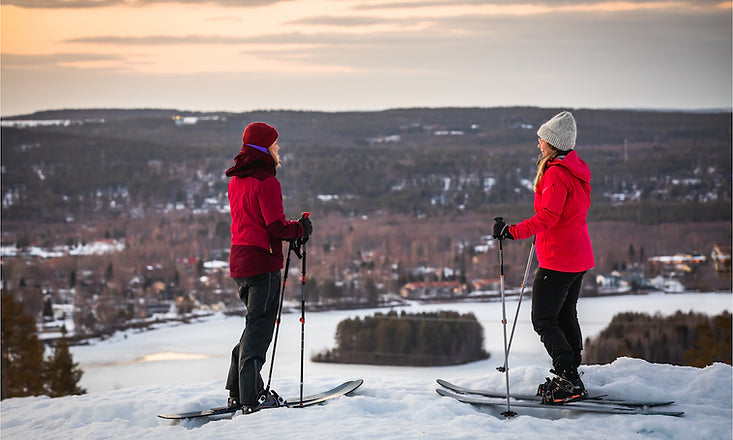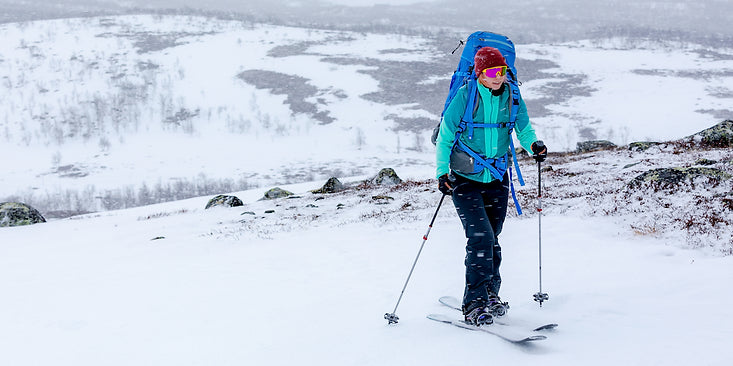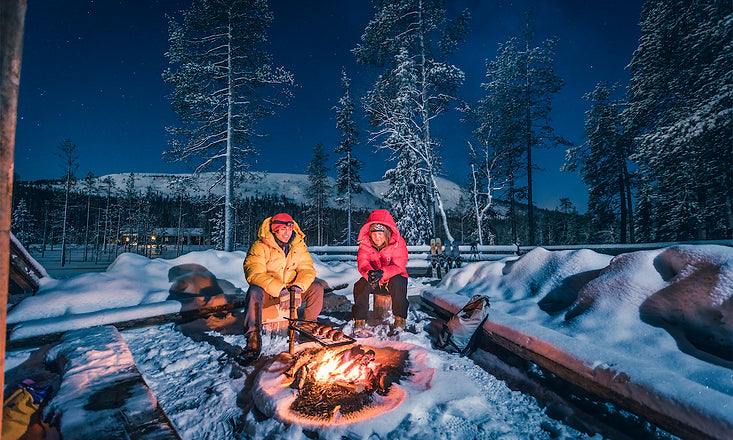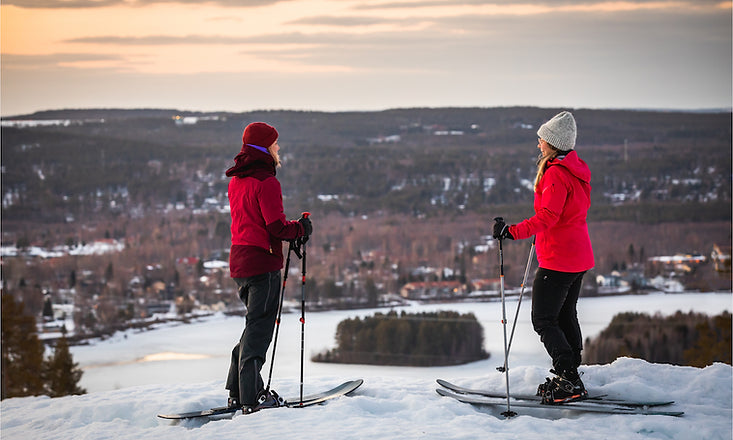
The Fundamentals
Whether heading out in the backyard for a simple five-minute joy ride, or readying yourself for a multi-week expedition, the fundamentals are the absolute necessities and critical for any Skinbased outing.
Skinbased skis: Personal goals and snow conditions will have a large impact on which skis will be the most appropriate for your chosen adventure. Check out our blog post, "Tips for Choosing the Right Skinbased Ski" for advice on determining which ski is the best fit for you.
Poles: Ski poles are another critical component of your skiing system. Not only will they help to propel you during forward and upward motion, but they can also assist in balance and be used as a timing device while making turns on descents. We recommend a pair of adjustable or collapsible carbon fiber or aluminum ski poles, such as the Black Diamond Traverse or Carbon Compactor. At the end of an awesome day of skiing, there isn’t much more satisfying than tapping poles with your partners in celebration of a job well done!
Boots: OAC’s EA Universal Bindings are compatible with a vast range of flexible-soled shoes and boots, ranging from size 33/34 up to size 48 on the European scale, and from 2Y (kids) to 13.5 men's/15 women's in US/Canadian. While not so highly recommended, they have even been skied before with flip flops! Whichever footwear you choose, make sure they are well broken in and are sized big enough to incorporate a thick sock (or two), should the weather require it. We also recommend something with a waterproof upper, and a collar that comes up over the ankle, both to provide ankle support and to help keep out snow. Boots that offer some flex in the forefoot while still providing torsional stability to support against rotational forces are the best. One great choice would be the La Sportiva Trango TRK GTX. Lastly, it's worth noting that our bindings are not compatible with fully rigid-soled footwear (like mountaineering and ice climbing boots), so please take this into consideration.
Clothing: What does the humble onion have in common with a good winter clothing system? Layers! Wearing multiple thinner layers of wicking clothing (such as synthetic fabrics or wool), versus fewer, thicker layers, offers a plethora of benefits. Most importantly, it helps with moisture management (i.e. sweat), warmth's biggest enemy in winter. Dressing in layers allows you to more easily remove clothing when you find yourself getting too hot, preventing sweat before it begins. It also allows sweat to more easily transfer from one layer to another, moving moisture off of and away from your skin. Thus, after an exertion, your skin will not become cold and clammy during a break in activity. If that wasn’t enough, each layer traps a thin layer of air between it and your skin. This dead air space is crucial for preserving your body’s own heat and keeping the cold air at bay.
The Ten Essentials
For any trip where you will leave sight of civilization, strongly consider bringing a backpack with the Ten Essentials in it. These items will not only give you an increased safety margin if something goes wrong, but can also simply make your day out more enjoyable. You can also fine-tune this list to meet your specific needs for the day

1. Food: Consider what preparation options are available to you. Are you going to a hut where there will be a fire? If so, a stick-roasted sausage is a Finnish favorite. Will you be outside all day in below freezing temperatures? Bring food with low-moisture content that is less likely to freeze. Ice cream is a fun dessert for days when you are sure it won't melt. Want to warm up while on the go? You can bring hot food in a Hydro Flask Insulated Food Flask or other vacuum-insulated bottle.
2. Water: It is easy to get dehydrated in winter, as you often don't notice yourself sweating. Bring both water and your favorite warm drink in an insulated bottle like those made by Hydro Flask to encourage drinking and prevent freezing.
3. Extra clothes: Remember layers! See “The Fundamentals” section above for more information.
4. Navigation: Having a map and compass, along with the skills to use them, can help keep you on your planned route and knowing where to go next. If you are reliant on a gps or phone for navigation, remember to take extra batteries and a charging cable, as the cold will often cut battery life dramatically. Be sure to keep your phone stored in a waterproof case to keep melted snow and moisture at bay.
5. Light source: A small LED headlamp such as the Black Diamond Spot 400 or 400-R is a great tool to always keep in your pack. The days are shorter in winter, and darkness can sometimes catch you unexpectedly. Again, be sure to keep your headlamp's battery fully charged and/or bring extra batteries, as the cold can really shorten their lifespan.
6. Sun protection: Just because it is cold out and the snow is down, doesn’t mean that the sun’s UV rays are taking a break. In fact, thanks to the reflection of light off of the snow, the effects of the sun’s rays on your skin can actually be more intense than during the summer months! Even if it is cloudy out, be sure to use and have with you lip balm, sun screen, and sunglasses to protect any exposed skin.
7. First aid: A proper first aid kit, and the knowledge of how to use it, can help keep not only your group, but other winter enthusiasts safe. If you plan to spend time away from civilization, it is highly recommended that you take a wilderness-specific first aid course. Pro tip - make sure your first aid kit has a whistle in it.
8. Fire: Carry your small fire-starting kit in a waterproof bag. Consider bringing at least two different ways to start a fire, such as matches and a lighter. Also, a small collection of tinder/fire-starter can be handy.
9. Tools: A multipurpose tool with a knife, screw driver, and pliers is an extremely useful outdoor tool for everything from opening hotdog packages to repairing a ski binding.
10. Shelter: This can be as simple as an ultralight emergency blanket/bivy sack. The goal of this shelter is to be used for emergencies only and is not supposed to be comfortable, only to help you survive in the event of a catastrophe.

There is no shortage of other equipment that you can bring along on your adventures. While the majority of it may not be necessary for most outings, some areas and trips will require you to bring additional supplies. For more committing outings, a few spare binding parts such as an extra toe strap or rubber spring can increase the reliability of an already dependable product. In areas where avalanche danger could be present, avalanche safety equipment is essential. While it is beyond the scope of this article to discuss snow safety, it is of critical importance to anyone recreating in terrain where avalanches could occur. We strongly recommend starting off by exploring areas with no avalanche danger, and taking a snow safety course from a trained professional before entering such terrain.
By now we hope you have a good idea what supplies you should bring with you to have a fun, safe, and successful day out on your OAC skis. If you want, feel free to share a photo and your thoughts from your next Skinbased trip with us via our social media accounts, @skinbased and facebook.com/skinbased. We always love seeing and being inspired by our wonderful Skinbased fans!

0 comments